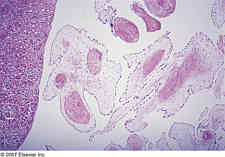Fibroelastoma papillary - function of the aortic valve

What is Fibroelastoma
Fibroelastoma is a noncancerous, connective tissue tumor that arises from the ENDOCARDIUM, usually on or near a HEART valve. Also called cardiac papillary fibroelastoma, this rare tumor can become serious or life threatening when it interferes with the function of a heart valve. Fibroelastomas most commonly form on or near the aortic valve or the tricuspid valve. They may become large enough to prevent the valve’s proper function or to block the flow of BLOOD through the valve. A fibroelastoma may also create turbulence in the heart, allowing blood to pool and clot. Generally fibroelestomas cause no symptoms and cardiologists may detect them incidentally during echocardiogram for other purposes. Because fibroelastomas pose such a significant risk for clotting and STROKE, cardiologists typically recommend surgery to remove them. Cardiologists do not know what causes fibroelastomas, though there is some debate whether they are congenital or acquired.
See also ANTICOAGULATION THERAPY; OPEN HEART SURGERY; SURGERY BENEFIT AND RISK ASSESSMENT; VALVULAR HEART DISEASE.